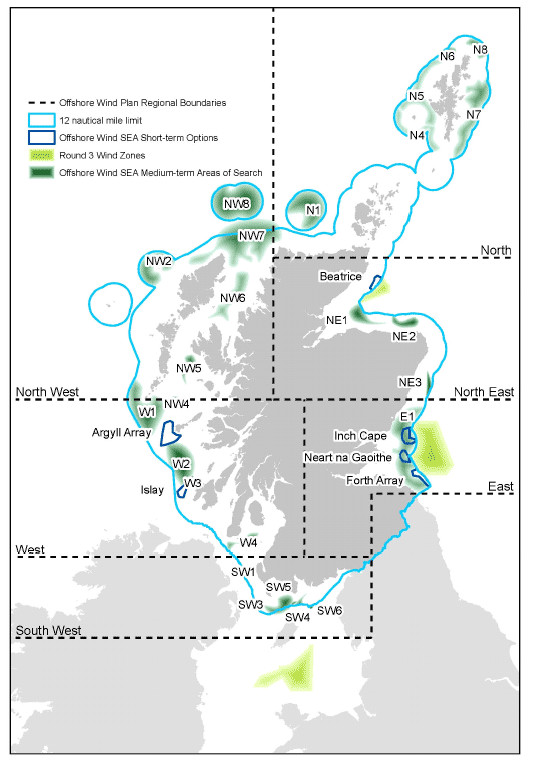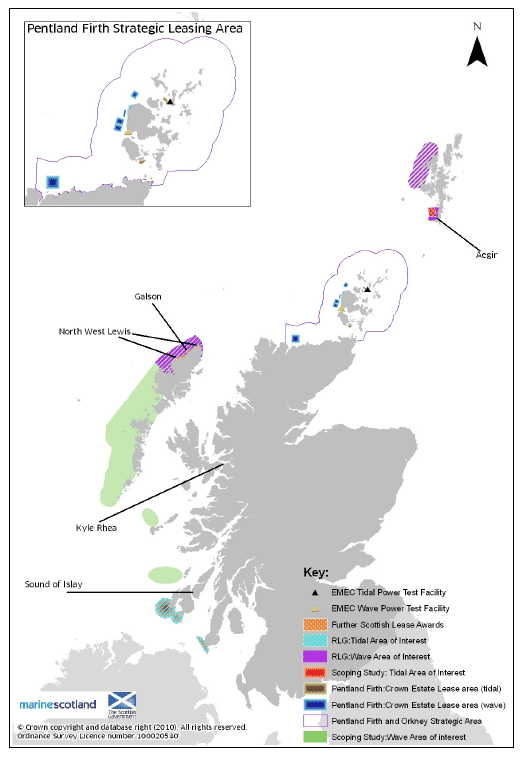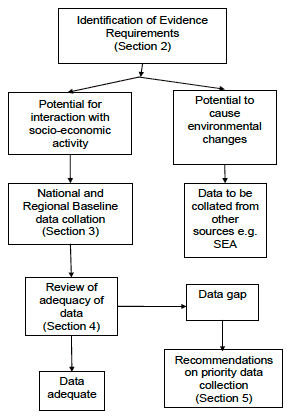Socio-economic Baseline Review Methodology and Data Gap Analysis for Offshore Renewables in Scottish Waters
The Data Gap Analysis Report summarises the background to and aims of the overall appraoch to socio-economics and offshore renewable energy planning. It sets out the approach that has been adopted to identifying baseline information requirements, which ta
1. Introduction
ABP Marine Environmental Research Ltd ( ABPmer) and RPA have been commissioned by Marine Scotland to prepare a national and six regional socio-economic baseline reviews that can be used to inform impact assessments for future sectoral plans for offshore wind, wave and tidal development.
This document summarises the background to and aims of the study and sets out the approach that has been adopted to identifying baseline information requirements, which takes account of potential interactions between offshore renewables development and marine uses and other interests.
A draft version of this document has been used to engage the Project Steering Group and wider stakeholders in clarifying the information requirements and thus to focus the scope and content of the baseline reviews.
1.1 Background to Study
Marine Scotland (on behalf of Scottish Ministers) is responsible for marine planning in Scottish Territorial Waters (0-12 nautical miles (nm)) and the waters offshore of Scotland (12-200nm), collectively referred to in this report as 'Scottish Waters'. In addition to the ongoing development of National and Regional Marine Plans, Marine Scotland is also developing sectoral plans for offshore wind and wave and tidal development for Scottish waters.
In March 2011, Marine Scotland published a Sectoral Marine Plan for Offshore Wind Energy in Scottish Territorial Waters (Marine Scotland, 2011a). Marine Scotland is now in the process of developing a Sectoral Marine Plan for Wave and Tidal Energy in Scotland's Renewable Energy Zone (0-200nm) and a Review of the Sectoral Marine Plan for Offshore Wind Energy (to now include 0-200nm).
The Plan for Offshore Wind contains six sites for development which have a potential generation capacity of around 5.4 GW. The plan also contains a further 25 'areas of search' for potential development (Figure 1). The Plan will be reviewed over a 2 year period. The scope of the Plan Review will be extended to include the extent of Scotland's Renewable Energy Zone (out to 200nm).
Marine Scotland is also developing a Sectoral Marine Plan for Wave and Tidal Energy in Scotland's Renewable Energy Zone (0-200nm). An Initial Plan Framework is currently being finalised, which will provide a strategic overview of where wave and tidal development could be progressed between 0-12nm. Figure 2 provides a map of the locations of the leased areas and the areas of opportunity identified by Marine Scotland.
Socio-economic impact assessments will be undertaken as part of the development of these plans. The programme of work to complete these impact assessments will contain three distinct but interconnected stages:
- Stage 1 - Socio-Economic Baseline Review and Data Gap Analysis;
- Stage 2 - Required Studies to address Data Gaps; and
- Stage 3 - Impact Assessments Stage, which will include:
- Socio-economic Impact Assessment of the Wave and Tidal Energy Sectoral Marine Plan;
- Socio-economic Impact Assessment of Offshore Wind Sectoral Plan (as part of the overall review of this plan);
- Cumulative Socio-economic Impact Assessment of Offshore Wind and Wave and Tidal Energy;
- Business and Regulatory Impact Assessment for the Sectoral Marine Plan Review for Offshore Wind Energy; and
- Business and Regulatory Impact Assessment for the Sectoral Marine Plan for Wave and Tidal Energy.
The Socio-Economic Baseline Review and Data Gap Analysis (this study) is the first of these three stages. The findings from this specific project will inform the studies undertaken in Stage 2 and will also underpin the impact assessments undertaken in Stage 3.
1.2 Study Aims
The broad aims for Stage 1 (this study) are to:
- Identify data and evidence requirements for constructing baselines to assess the potential social and economic impacts of offshore wind, wave and tidal energy on marine uses and other interests at regional levels;
- Use existing data and evidence to identify related social and economic activities taking place on land and within specific areas of Scotland's Renewable Energy Zone identified for potential offshore wind, wave and tidal energy development;
- Map both the intensity and value of these activities, and assess how these activities have changed over time and may change in the future;
- Identify social and economic activities taking place within specific areas of Scotland's Renewable Energy Zone for which the required data or evidence does not exist, and which will need to be developed to allow comprehensive assessments of impacts to be undertaken; and
- Recommend methodologies for addressing identified data and evidence gaps, and advise on the extent to which these would be successful.
The project is focusing on regional subdivisions of Scotland's Renewable Energy Zone. For the purposes of this work, 'regions' are those established within the Sectoral Marine Plan for Offshore Wind in Scottish Territorial Waters and will be termed the Scottish Offshore Renewable Energy Regions (s) ( SORER). Within these regions, the analysis has concentrated on previously identified areas for development of Offshore Wind Energy (Figure 1) and Wave and Tidal Energy (Figure 2).
Figure 1. Short-term Sites and Medium Term Areas of Search
for Offshore Wind
(Marine Plan for Offshore Wind Energy in Scottish
Territorial Waters)

Figure 2. Map of Wave and Tidal Lease Areas and Areas of
Opportunity
(Initial Plan Framework)

1.3 Project Oversight
The project has been managed by Marine Scotland's Marine Renewables policy team. Advice and comment has also been provided by a Steering Group involving relevant national stakeholders. The Steering Group met on two occasions to discuss the proposed approach and evidence requirements (2 November 2011) and to provide comments on the draft project outputs (7 December 2011). A list of organisations represented on the Steering Group is provided at Appendix A.
The project was undertaken by ABPmer supported by Risk & Policy Analysts ( RPA) in the period September - January 2012.
1.4 Methodology
The study has been progressed through completion of the following tasks, described in more detail below and as shown in Figure 3:
- Identifying the evidence requirements;
- Preparation of national and regional baseline reviews;
- eview of data adequacy and data gap analysis; and
- Recommending data collection methodologies for priority data gaps.
Figure 3. Flow Diagram of Methodology Process

These stages are described in more detail in the following sections. The baseline report structure was discussed in the first Steering Group meeting and an example of a draft baseline review was copied to the Steering Group for comment and the full baseline review was discussed at the second Steering Group meeting. The documents were finalised in the light of comments received and a comments log identifying how all comments received had been addressed was provided to Marine Scotland.
1.5 Structure of Report
This report is structured into the following sections:
- Section 1 - Introduction (this section);
- Section 2 - Identifying the Evidence Requirements;
- Section 3 - Preparation of Baseline Reviews;
- Section 4 - Review of Data Adequacy and Data Gap Analysis; and
- Section 5 - Recommendations to Fill Data Gaps.
The national and regional baseline reviews are presented in a separate volume ( ABPmer & RPA 2012a).
Contact
There is a problem
Thanks for your feedback